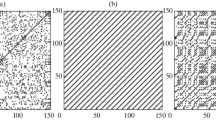Abstract
The recently developed qualitative method of diagnosis of dynamical systems — recurrence plots has been applied to the analysis of dynamics of neuronal spike trains recorded from cerebellum and red nucleus of anesthetized cats. Recurrence plots revealed robust and common changes in the similarity structure of interspike interval sequences as well as significant deviations from randomness in serial ordering of intervals. Recurring episodes of alike, quasi-deterministic firing patterns suggest the spontaneous modulation of the dynamical complexity of the trajectories of observed neurons. These modulations are associated with changing dynamical properties of a neuronal spike-train-generating system. Their existence is compatible with the information processing paradigm of attractor neural networks.
Similar content being viewed by others
References
Aikara K, Matsumoto G (1986) Chaotic oscillations and bifurcations in squid giant axons. In: Holden AV (eds) Chaos. Manchester University Press, Manchester, pp 257–269
Albano AM, Mees AI, de Guzman GC, Rapp PE (1987) Data requirements for reliable estimation of correlation dimensions. In: Degn H, Holden AV, Olsen LF (eds) Chaos in biological systems. Plenum, New York, pp 207–220
Albus JS (1971) A theory of cerebellar function. Math Biosci 10:25–61
Amit DJ, Treves A (1989) Associative memory neural networks with low temporal spiking rates. Proc Natl Acad Sci USA 86:7871–7876
Babloyantz A, Nicolis C, Salazar M (1985) Evidence of chaotic dynamics of brain activity during the sleep cycle. Phys Lett 111A:152–156
Basar E, Bullock TH (eds) (1989) Brain dynamics. Springer, Berlin Heidelberg New York
Braitenberg V (1987) The cerebellum and the physics of movement: some speculations. In: Glickstein M, Stein J, Yeo C (eds) Cerebellum and neuronal plasticity. Plenum, New York, pp193–207
Brooks VB, Thach WT (1981) Cerebellar control of posture and movement. In: Brooks VB (eds) Handbook of physiology, sect 1, The nervous system, vol II, Motor control. American Physiological Society, Bethesda, pp 877–946
Chapeau-Blondeau F, Chauvet G (1991) A neural network model of the cerebellar cortex performing dynamic associations. Biol Cybern 65:267–279
Chay TR (1984) Abnormal discharges and chaos in a neural model. Biol Cybern 50:301–311
Dayhoff J, Gerstein GL (1983) Favored patterns in spike trains. I. Detection. J Neurophysiol 49:1334–1348
Ebner TJ, Bloedel JR (1981) Temporal patterning in simple spike discharge of Purkinje cells and its relationship to climbing fiber activity. J Neurophysiol 45:933–947
Eckmann J-P, Kamphorst Oliffson S, Ruelle D (1987) Recurrence plots of dynamical systems. Europhys Lett 4:973–977
Farmer JD, Sidorowich JJ (1987) Predicting chaotic time series. Phys Rev Lett 59:845–848
Gahwiller BH, Mamoon AM, Tobias CA (1973) Spontaneous bioelectrical activity of cultured cerebellar Purkinje cells during exposure to agents that prevent synaptic transmission. Brain Res 53:71–79
Gallez D, Babloyantz A (1991) Predictability of human EEG: a dynamical approach. Biol Cybern 64:381–391
Glass L, Mackey MC (1988) From clocks to chaos: the rhythms of life. Princeton University Press, Princeton
Ito M (1984) The cerebellum and neural control. Raven Press, New York
Keeler JD (1990) A dynamical system view of cerebellar function. Physica D 42:396–410
Klemm WR, Sherry CJ (1981) Serial ordering in spike trains: “What's it trying to tell us?” Int J Neurosci 14:15–33
Landolt JP, Correia MJ (1978) Neuromathematical concepts of point process theory. IEEE Trans Biomed Eng 25:1–12
MacGregor RJ (1991) Sequential configuration model for firing patterns in local neural networks. Biol Cybern 65:339–349
Marczynski TJ, Burns LL, Monley C (1992) Empirically derived model of the role of sleep in associative learning and recuperative processes. Neural Networks 5:371–402
Marr D (1969) A theory of cerebellar cortex. J Physiol (Lond) 202:437–470
Mayer-Kress G, Yates FE, Benton L, Keidel M, Tirsh W, Poppl SJ, Geist K (1988) Dimensional analysis of nonlinear oscillations in brain, heart, and muscle. Math Biosci 90:49–70
Mood AM (1940) Distribution theory of runs. Ann Math Stat 11:367–392
Mpitsos GJ, Burton RM, Creech HC, Soinila SO (1988a) Evidence for chaos in spike trains of neurons that generate rhythmic motor patterns. Brain Res Bull 21:529–538
Mpitsos GJ, Creech HC, Cohan CS, Medelson M (1988b) Variability and chaos: Neurointegrative principles in self-organization of motor patterns. In: Kelso JAS, Mandell AJ, Schlesinger MF (eds) Dynamic patterns in complex systems. World Scientific, Teaneck, NJ, pp 162–190
Murphy JT, Sabah NH (1970) Spontaneous firing of cerebellar Purkinje cells in decerebrate and barbiturate anesthetized cats. Brain Res 17:515–519
Nakahama H, Ishii N, Yamamoto M, Saito H (1971) Stochastic properties of spontaneous impulse activity in central single neurons. Tohoku J Exp Med 104:373–409
Nicolis JS (1986) Chaotic dynamics applied to information processing. Rep Progr Phys 49:1109–1196
Rapp PE, Zimmermann ID, Albano AM, de Guzman GC, Greenbaum NN (1985) Dynamics of spontaneous neural activity in the simian motor cortex. Phys Lett 110A:335–338
Roschke J, Basar E (1989) Correlation dimensions in various parts of cat and human brain. In: Basar E, Bullock TH (eds) Brain dynamics. Springer, Berlin Heidelberg New York, pp 131–148
Sherry JC, Barlow DI, Klemm WR (1982) Serial dependencies and Markov properties of neuronal interspike intervals from rat cerebellum. Brain Res Bull 8:163–169
Tarnecki R (1988) Functional connections between neurons of interpositus nucleus of cerebellum and the red nucleus. Behav Brain Res 28:117–125
Author information
Authors and Affiliations
Rights and permissions
About this article
Cite this article
Kałużny, P., Tarnecki, R. Recurrence plots of neuronal spike trains. Biol. Cybern. 68, 527–534 (1993). https://doi.org/10.1007/BF00200812
Received:
Accepted:
Issue Date:
DOI: https://doi.org/10.1007/BF00200812




